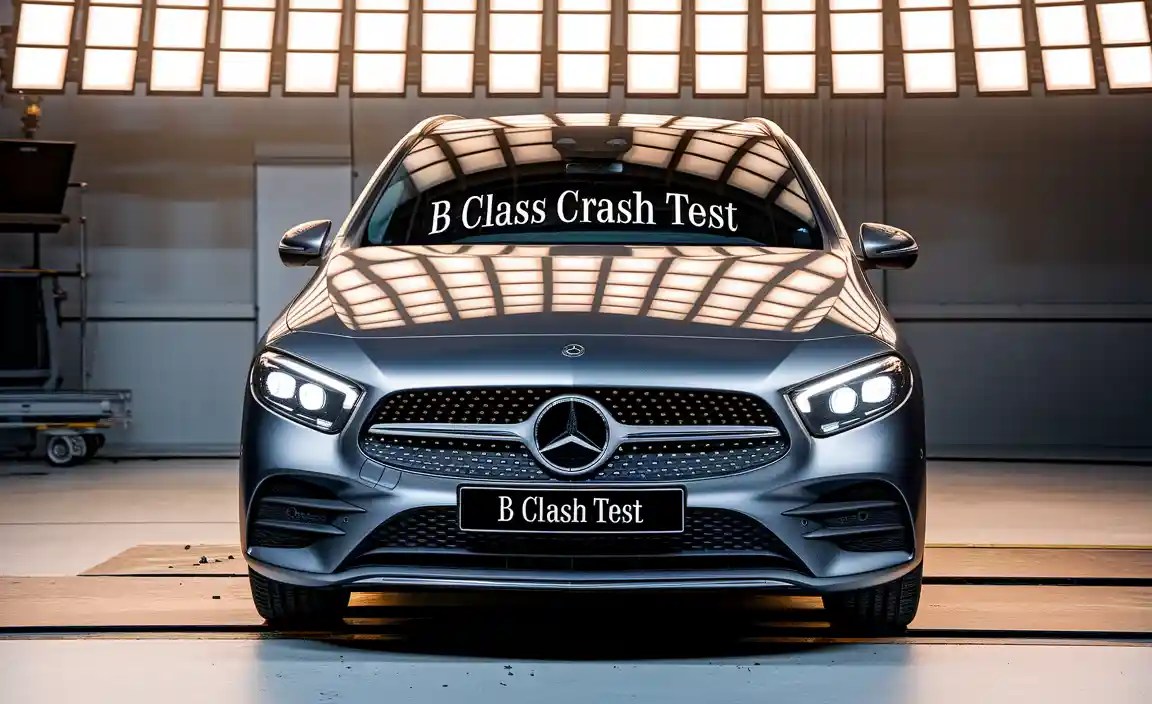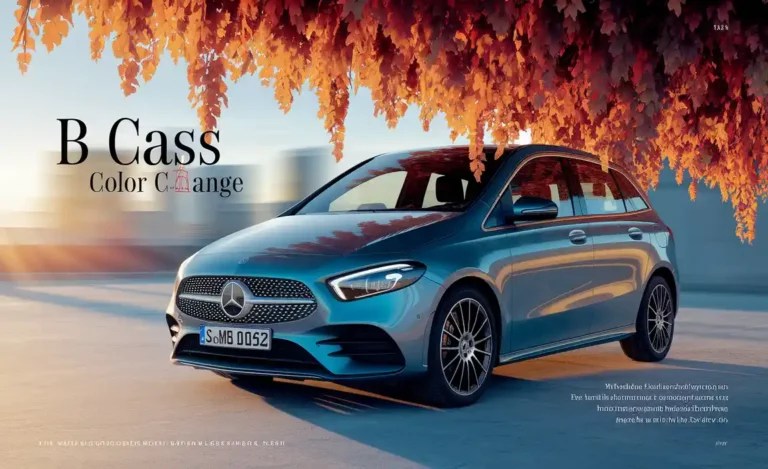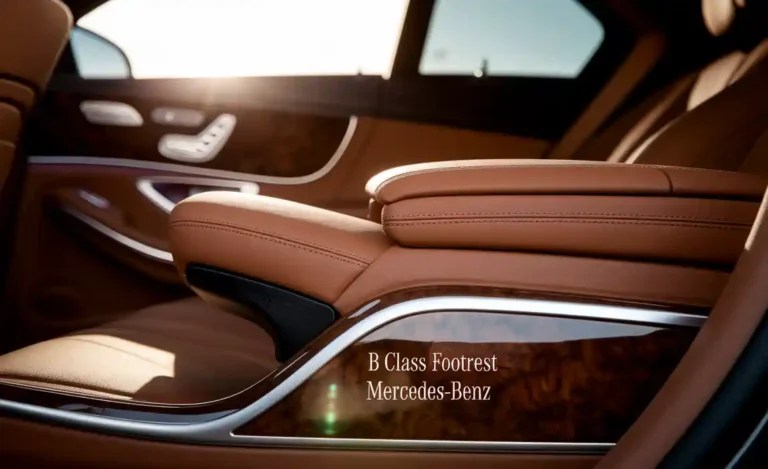B Class Crash Test: Ultimate Safety for Effortless Drives
Understanding the B Class crash test results is crucial for anyone prioritizing safety in their Mercedes-Benz. These tests are designed to assess how well a vehicle protects occupants during various collision scenarios. For the Mercedes-Benz B-Class, these evaluations consistently highlight its robust engineering and advanced safety features, giving you peace of mind on every journey. We’ll break down what these tests mean and why they matter for your driving experience.
Mercedes-Benz has always placed paramount importance on safety, and the B-Class isn’t an exception. It’s a premium compact vehicle designed for everyday life, families, and those who appreciate a blend of practicality and advanced technology. Knowing how it performs in rigorous crash tests can significantly influence your purchase decision and enhance your confidence behind the wheel. This guide will demystify the B Class crash test results, explaining the methodology and the remarkable outcomes.

Understanding Car Safety Ratings

Before diving into the specifics of the B Class crash test, it’s helpful to understand the general landscape of car safety ratings. Several organizations conduct independent crash tests to evaluate vehicle safety. The most prominent globally include:
- Euro NCAP (European New Car Assessment Programme): This is a highly respected independent safety assessment program for vehicles in Europe. They award star ratings from one to five, with five stars indicating the highest level of safety.
- NHTSA (National Highway Traffic Safety Administration): The U.S. Department of Transportation’s agency that rates vehicles based on crashworthiness and rollover resistance. They also use a star system, ranging from one to five.
- IIHS (Insurance Institute for Highway Safety): An independent, nonprofit organization funded by auto insurers. They conduct extensive crash tests and award “Top Safety Pick” and “Top Safety Pick+” designations.
These organizations use standardized tests that simulate real-world accident conditions. They assess:
- Frontal Impact: Simulates a head-on collision with a barrier or another vehicle.
- Side Impact: Simulates a collision with an object or another vehicle at an intersection.
- Side Pole Impact: Simulates hitting a pole or tree at speed, testing protection for occupants in a narrower and more severe side impact.
- Rear Impact (Whiplash): Evaluates how well the seats and head restraints protect against neck injuries in a rear-end collision.
- Pedestrian Safety: Assesses the vehicle’s impact on pedestrians in the event of a collision.
- Active Safety Systems: Evaluates the effectiveness of features like automatic emergency braking, lane keeping assist, and blind-spot monitoring.
Each test contributes to an overall safety score or rating. A higher rating signifies better protection for occupants and reduced risk of injury.
The Mercedes-Benz B-Class: A Commitment to Safety

The Mercedes-Benz B-Class is a versatile compact car that has consistently been engineered with a strong emphasis on occupant safety. It’s designed to be a practical family car, an executive commuter, or a comfortable vehicle for any journey. This inherent dedication to safety is reflected in its crash test performance. Mercedes-Benz equips the B-Class with a comprehensive suite of active and passive safety systems. Passive safety refers to systems that protect occupants during a crash, such as airbags and the vehicle’s structural integrity. Active safety systems, on the other hand, aim to prevent accidents from happening in the first place, like advanced driver-assistance systems (ADAS).
When models like the B-Class undergo rigorous testing by organizations like Euro NCAP, the results often demonstrate the effectiveness of Mercedes-Benz’s safety philosophy. The brand invests heavily in research and development to create strong body structures, advanced restraint systems, and intelligent electronic aids. This commitment means that owners can drive with a greater sense of security, knowing their vehicle is built to withstand significant forces and help avoid potential hazards.
Euro NCAP: B Class Crash Test Explained
Euro NCAP is a cornerstone for evaluating vehicle safety in Europe, and its assessments are highly influential. The testing protocols are stringent and evolve regularly to reflect modern traffic risks and technological advancements. For the Mercedes-Benz B-Class, Euro NCAP tests typically yield impressive results, often achieving the highest possible star rating.
Here’s a breakdown of how the B-Class generally performs in key Euro NCAP areas:
Adult Occupant Protection
This is a critical aspect, focusing on how well the vehicle protects adults seated in the front and rear during various impact scenarios. The B-Class typically scores very high in this category. This is due to:
- Robust Body Structure: The vehicle’s frame is designed to absorb and dissipate impact energy, preventing it from entering the passenger compartment. This includes a high-strength safety cell.
- Advanced Airbag Systems: A comprehensive set of airbags, including front, side, curtain, and sometimes knee airbags, deploy strategically to cushion occupants and prevent contact with hard surfaces.
- Pre-tensioning Seatbelts and Load Limiters: These systems ensure the seatbelt is snug at the moment of impact, and then precisely manages the force exerted by the belt, reducing chest injuries.
Child Occupant Protection

Euro NCAP places significant importance on protecting younger passengers. The B-Class is assessed using child-sized dummies in various child restraint systems (CRS). High scores indicate:
- Effective ISOFIX Anchorage Points: These standardized mounting points make it easier and more secure to install child seats.
- Proper Seatbelt Guidance: The vehicle’s design facilitates correct seatbelt routing for different types of child seats.
- Protection in Key Areas: The crash structure and airbag systems are designed to minimize the risk of injury to children, even in side impacts.
Pedestrian Safety
This evaluation looks at how the vehicle’s front-end design might affect a pedestrian in a collision. The B-Class generally performs well due to features like:
- Bonnet Design: The shape and energy-absorbing properties of the bonnet can reduce the severity of head impacts.
- Bumper and Front Edge: The design of the bumper and the leading edge of the bonnet are assessed for their impact on leg injuries.
- Windscreen and Pillar Design: These areas are also considered for their potential impact on pedestrian heads.
Safety Assist Systems
Modern vehicles are judged not just on passive protection but also on their ability to help prevent accidents. The B-Class often excels here due to its standard and optional advanced driver-assistance systems (ADAS). These include:
- Active Brake Assist: This system can detect potential collisions with vehicles, pedestrians, and cyclists and automatically apply the brakes if the driver doesn’t respond. You can learn more about the NHTSA’s perspective on intelligent transportation systems, which includes many ADAS technologies.
- Active Lane Keeping Assist: Helps keep the vehicle within its lane by providing steering intervention.
- Blind Spot Assist: Warns the driver of vehicles in their blind spots.
- Attention Assist: Detects signs of drowsiness in the driver and alerts them.
- Speed Limit Assist: Can recognize speed limit signs and adjust the cruise control accordingly.
These systems work collaboratively to create a safer driving environment, reducing the likelihood of accidents and mitigating their severity if they do occur. A five-star Euro NCAP rating for the B-Class is a testament to this holistic approach to safety design.
NHTSA and IIHS Ratings for the B-Class
While Euro NCAP is the primary testing body in Europe, similar evaluations are conducted in North America by NHTSA and IIHS. While specific ratings can vary slightly by model year and region, Mercedes-Benz vehicles, including the B-Class variants available in those markets, generally perform very well.
NHTSA (National Highway Traffic Safety Administration)
NHTSA uses a star rating system from 1 to 5. A 5-Star Overall Safety Rating indicates the highest level of protection. For vehicles that achieve this, NHTSA assesses:
- Frontal Crash: Tests how well the vehicle protects occupants in a head-on collision.
- Side Crash: Evaluates protection in a side-impact collision. This includes front and rear passenger seats and a barrier crash.
- Side Pole Crash: Tests how well the vehicle protects occupants in a severe side impact, such as hitting a pole.
- Rollover: Assesses the vehicle’s tendency to roll over in a single-vehicle crash. Statistics suggest that about 57% of all fatal crashes are rollovers.
Mercedes-Benz vehicles, including the B-Class, are typically designed to meet and exceed the stringent requirements for these tests, often earning 5-star ratings in relevant categories.
IIHS (Insurance Institute for Highway Safety)
The IIHS provides two prestigious awards: “Top Safety Pick” and “Top Safety Pick+”. These awards require a vehicle to perform well in their battery of tests, which often include more demanding scenarios than government tests. Their key tests include:
- Small Overlap Front: This tough test simulates a collision where only a small portion of the vehicle’s front end strikes a barrier. It’s a critical test for assessing how well the vehicle’s safety structure performs.
- Moderate Overlap Front: A more traditional frontal crash test where 40% of the front of the vehicle collides with a barrier.
- Side: A test involving a barrier moving at 31 mph into the driver’s side of the vehicle.
- Roof Strength: Evaluates the vehicle’s ability to withstand force when the roof is crushed.
- Head Restraints and Seats: Assesses the effectiveness of head restraints in preventing whiplash injuries in rear-end collisions.
The highest accolades from IIHS, such as Top Safety Pick+, are awarded to vehicles demonstrating superior performance in all these areas, particularly in the small overlap front and side crash tests, and by having advanced front crash prevention systems. Given Mercedes-Benz’s engineering prowess, the B-Class variants sold in markets where these tests are conducted often qualify for these top honours.
Key Safety Innovations in the B-Class
The B-Class isn’t just about a strong structure; it’s packed with innovative technologies designed to enhance safety. These systems work in harmony to protect occupants and assist the driver.
PRE-SAFE® System
This is a signature Mercedes-Benz technology. The PRE-SAFE® system can detect a potential crash before it occurs and can take preventative measures to protect occupants. This includes:
- Tensioning of seatbelts: When a critical situation is detected, seatbelts can be tensioned to hold occupants firmly in their seats.
- Closing windows and sunroof: If a rollover or severe side impact is imminent, the windows and sunroof can be automatically closed to ensure the effectiveness of the side airbags and curtain airbags.
- Adjusting front passenger seat: In some cases, the front passenger seat can be moved to a more optimal position.
Active Distance Assist DISTRONIC®
This adaptive cruise control system maintains a set speed and automatically adjusts it to keep a safe distance from the vehicle ahead. It uses radar sensors to monitor traffic and can bring the car to a complete stop if necessary, then resume driving automatically.
Active Steering Assist
This system can help the driver stay in their lane on highways, even on gentle curves. It uses cameras to track lane markings and can provide gentle steering inputs to keep the vehicle centered.
Active Brake Assist with Cross-Traffic Function
Expanding on the basic emergency braking, this advanced system can detect approaching traffic and pedestrians, even at intersections, and can apply the brakes forcefully if a collision is unavoidable and the driver fails to react.
Attention Assist
As mentioned earlier, this system monitors driver behavior for signs of fatigue. By analyzing steering inputs and driving patterns, it can detect when a driver might be getting drowsy and alert them with visual and audible warnings.
Crash Test Performance: A Table of Key Features
To better illustrate the safety capabilities of the B-Class, let’s look at a table summarizing typical safety features that contribute to its strong crash test performance. Keep in mind that specific features may vary by model year and optional packages.
| Safety Feature Category | Specific Features Typically Found in B-Class | Impact on Crash Test Performance |
|---|---|---|
| Structural Integrity | High-strength steel passenger cell, crumple zones, reinforced pillars | Absorbs and redirects impact energy, maintaining occupant space. Crucial for high scores in frontal and side impacts. |
| Passive Restraint Systems | Multi-stage front airbags, side airbags, window airbags, knee airbags, seatbelt pre-tensioners, seatbelt force limiters | Minimize occupant movement during a crash, reduce impact forces on the body, and prevent contact with vehicle interior. Essential for adult and child occupant protection ratings. |
| Active Safety Systems (ADAS) | Active Brake Assist, Active Lane Keeping Assist, Blind Spot Assist, Attention Assist, Adaptive Cruise Control (DISTRONIC®), Speed Limit Assist | Help prevent accidents, reduce speed before impact, and guide the driver. Significantly impact the “Safety Assist” category scores in Euro NCAP and contribute to IIHS “Top Safety Pick” awards by reducing crash frequency and severity. |
| Child Safety | ISOFIX child seat anchor points, LATCH system (in some markets), child lock features | Ensures secure and proper installation of child seats, protecting younger occupants. Directly assessed in child occupant protection tests. |
| Pedestrian Protection | Energy-absorbing bonnet, designed bumper | Reduces the severity of injuries to pedestrians in the event of a collision. Assessed in pedestrian safety tests. |
Why B Class Crash Test Results Matter for You
Understanding these crash test results isn’t just about numbers or stars; it’s about the tangible benefits they provide to you and your loved ones when you’re on the road. For anyone considering a Mercedes-Benz B-Class or already owning one, these ratings offer reassurance and confidence.
- Peace of Mind: Knowing that your vehicle has been rigorously tested and has achieved high safety ratings from independent bodies can provide significant peace of mind. This is especially important for families with young children or for long-distance journeys.
- Reduced Risk of Injury: The advanced engineering a high-scoring vehicle like the B-Class incorporates is specifically designed to minimize the risk and severity of injuries in an accident. This means better chances of walking away from a collision with less severe harm.
- Lower Insurance Premiums: In many regions, vehicles with excellent safety ratings may qualify for lower insurance premiums. Insurers recognize that safer vehicles are less likely to be involved in costly claims.
- Informed Purchase Decisions: For prospective buyers, crash test results are a vital piece of information when comparing different models and brands. They offer an objective measure of a vehicle’s ability to protect its occupants. For example, if you’re comparing the B-Class to a competitor, its superior crash test performance can be a deciding factor.
- Technological Advancement: The focus on active safety systems highlights the integration of sophisticated technology into everyday driving. These systems are like an extra set of eyes and a helping hand, making driving less stressful and safer. You can explore more about the innovations in Mercedes-Benz driver assistance systems to see the breadth of technology available.
The B-Class, by consistently performing well in these tests, demonstrates that Mercedes-Benz doesn’t compromise on safety, even in its more compact offerings. It’s a testament to their philosophy that safety is a fundamental aspect of luxury and driving enjoyment.
Frequently Asked Questions (FAQ)
What does a 5-star safety rating mean for the Mercedes-Benz B-Class?
A 5-star safety rating, typically from Euro NCAP or NHTSA, signifies that the Mercedes-Benz B-Class offers the highest level of protection for adult and child occupants across a range of crash scenarios. It also indicates good performance in protecting pedestrians and the effectiveness of its active safety assistance systems.
Are all Mercedes-Benz B-Class models equally safe?
While the core safety structure and many standard features are consistent across a model generation, specific safety ratings can vary slightly based on the model year, available optional safety packages, and the specific testing protocols of different organizations like Euro NCAP, NHTSA, and IIHS. It’s always best to check the specific safety ratings for the exact model year you are interested in.
What is the PRE-SAFE® system, and how does it work?
The PRE-SAFE® system is an anticipatory safety feature from Mercedes-Benz. It uses sensors to






